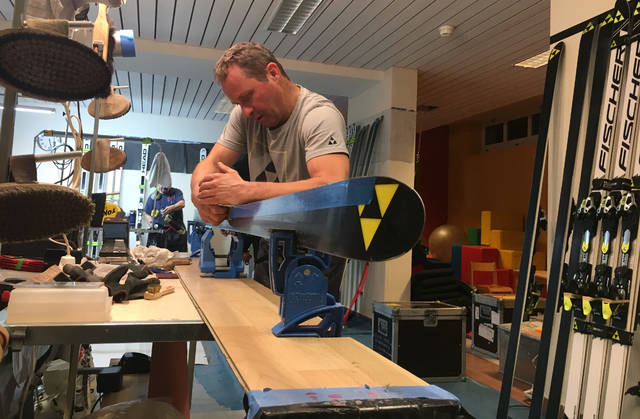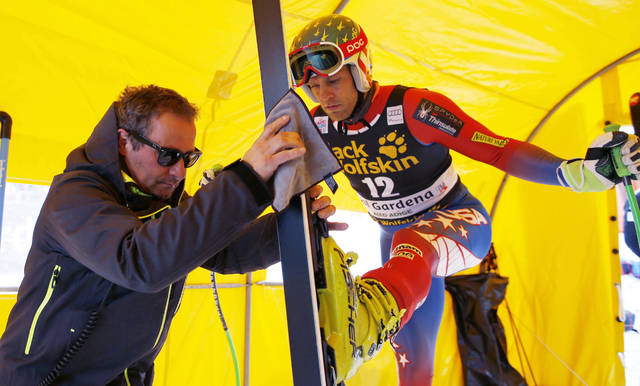

WENGEN, Switzerland (AP) — A warm aroma of melting wax curled out of the room where an unsung artisan of Alpine skiing was at work.
The trail led from a brightly lit basement, directly below a restaurant in a three-star hotel. It was a games room for most of the winter season in the Swiss Alps resort of Wengen, but pingpong tables were folded away during World Cup race week in January.
The space was needed for teams of technicians that spend hours hunched over workbenches, waxing the bases and sharpening the edges of skis to make a downhill racer like Lindsey Vonn that much faster.
Their work is crucial to any racer’s success at the Pyeongchang Olympics, which open next week. It started long before the games, during preseason equipment tests, through offseason training, and on race days.
Working mostly out of public view, often in hotel cellars, the so-called servicemen are little-known even to ski fans.
Leo Mussi was in Wengen trying to create speed in the skis of two American downhillers for one of the season’s classic races.
“We are really a little strange, I would say, too, us service guys,” Mussi, one of skiing’s most respected techs, told The Associated Press. “It’s a tough job, physically, mentally. You travel a lot, you are on the road. But it’s a kind of drug, too, this job.”
Top-ranked racers are matched with technicians by their ski sponsor. Lower-ranked racers and newcomers typically have their skis prepared by a serviceman with the national team.
At the very top, some can request the best techs in a limited free-agent market. When Bode Miller split with renowned serviceman Heinz Haemmerle in 2009, Vonn was quick to pounce.
“They call him ‘Magic Heinzi’ for a reason,” Vonn told the AP. “He has been doing this for almost as long as I have been alive. He is amazing and I trust him completely.”
That faith helps bind a skier’s courage and racing instinct to hit speeds of up 145 kph (90 mph) on the mountain.
Mussi has dedicated almost 30 working years to two downhill racers — his fellow Italian Kristian Ghedina, and now American Steven Nyman — while employed by ski manufacturer Fischer.
“Leo is basically like a European father figure to me,” Nyman said. “I don’t even question him. I put the skis on and see they are going to be fast.”
Vonn’s ski tuner, Haemmerle, has long worked for the Head brand used by the men’s downhill favorites, Beat Feuz of Switzerland and Norwegians Aksel Lund Svindal and Kjetil Jansrud. Friendship trumps rivalry in the Norway team and they share skis and a technician, Stefan Berthold.
Pairing skier with serviceman is the job of Rainer Salzgeber, Head’s race director and a two-time Olympian for Austria.
“Some are really good buddies,” Salzgeber said. “But not every athlete wants to have a really close friend who is working on his material.”
In the full year of this Olympic season, he estimated, a skier and serviceman are away together for 200 days. That can mean equipment tests in the European spring, offseason training in South America, World Cup races in Europe and North America, the Winter Games in Asia, then back to Europe for season-ending races.
The special relationship is compared to that of a golfer and caddie. Except many caddies get days in the sun on television next to their golfer, plus 10 percent of prize money that routinely runs six figures.
The richest World Cup races — a men’s downhill at Kitzbuehel, a women’s slalom in Flachau, both in Austria — pay a first prize of less than $85,000. Not all skiers follow Nyman’s example in giving 10 percent to their serviceman.
“It’s a tough job,” Salzgeber said. “The only payback that you have is success, actually.”
Mussi has been part of 15 World Cup downhill wins, but also the kind of injuries that struck Nyman last week. His Olympic season was ended by a torn ACL in his right knee.
“You need to know you are not always on the top,” said Mussi, who also tunes skis for U.S. downhill prospect Bryce Bennett.
The camaraderie in hotel cellars helps. Mussi spoke at his workbench at the hub of a room for teams from Japan, South Korea, Slovakia and Poland.
A radio played classic rock and pop songs. Cans of beer were offered as the late afternoon work wound down, and a bottle of lotion was shared for inevitable hand injuries.
The tools of Mussi’s trade have improved since he simply taped his fingers before filing steel ski edges. Now, a metal guiding tool does more precise work, and wax-shining brushes can be attached to a hand drill.
It still needs a simple plastic scraper to remove layers of old wax — key to reducing friction between ski and snow — and Mussi uses a diamond file to finesse the edges just before a race.
Then, in the start house, as racers like Nyman peer down the mountain for a final few seconds, a ski tech can also be coach and motivator.
“You are a highly respected person,” Mussi said. “(The racers) know what they have.”
___
Associated Press writer Eric Willemsen in Bad Kleinkircheim, Austria, contributed to this report.
___
More AP Olympic coverage: https://wintergames.ap.org



